State Supreme Court Emails Show Chaotic First Week of Liberal Control
Documents offer portrait of a court at war with itself.
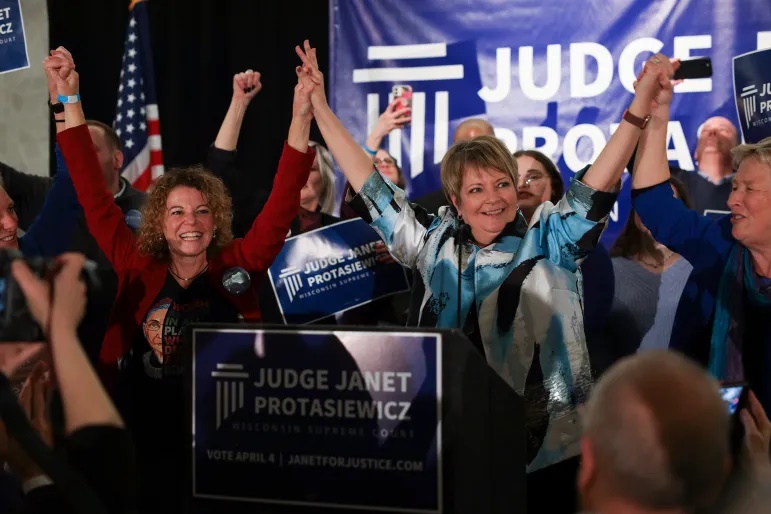
Justice Janet Protasiewicz, center, celebrates her victory on election night on April 4, 2023, with Justices Rebecca Dallet, left, Jill Karofsky, far left, and Ann Walsh Bradley, far right. The liberal majority has moved quickly to assert its control over the court. (Drake White-Bergey / Wisconsin Watch)
This story was originally published by Wisconsin Watch.
On Friday, Aug. 4, within hours of the Wisconsin Supreme Court’s new liberal majority voting to update rules cementing its control over court business, liberal Justice Rebecca Dallet shared the changes with all of the justices, but they included a typo. Conservative Chief Justice Annette Ziegler asked twice for a copy of the correct version.
Dallet’s law clerk wrote to the justices that the changes would not be released that day.
Fifteen minutes later, Dallet’s clerk sent Ziegler the document she requested. A half hour later, Ziegler, through a court spokesperson, emailed to the press the documents and a public statement declaring “four rogue members of the court met in a secret, unscheduled, illegitimate closed meeting in an attempt to gut the Chief Justice’s constitutional authority as administrator of the court.”
Two days later, on Sunday morning, after Ziegler told the Milwaukee Journal Sentinel she was an “eternal optimist” and “would like to think that we will be able to work well together,” Dallet wrote to Ziegler that she was “also optimistic that we can work together on court business.” She suggested they and the other member of a newly created administrative committee, liberal Justice Jill Karofsky, meet on Tuesday.
Ziegler was having none of it.
“I am not willing to violate my oath or the constitution,” Ziegler replied more than nine hours later, looping in the court’s other six justices. “You know that this invented ‘committee’ is in violation of your oath, the constitution and longstanding practice. It is illegitimate and unenforceable.”
She concluded: “I will not participate in your sham experiment.”
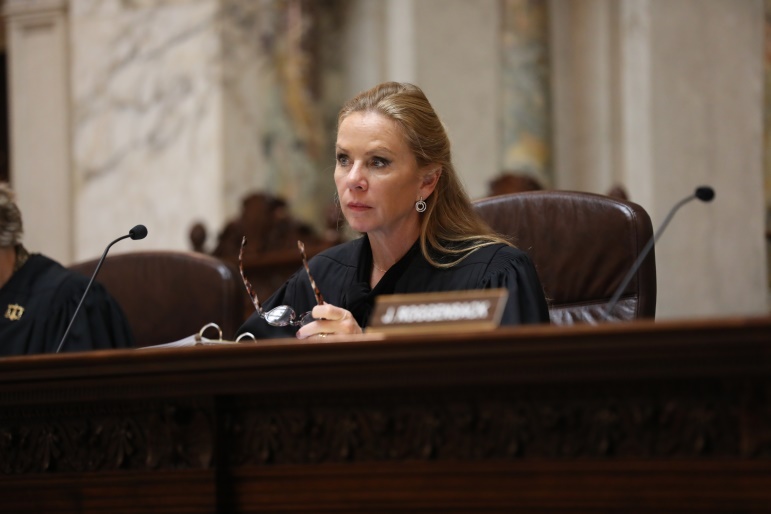
Conservative Chief Justice Annette Ziegler has tried to put the brakes on the Supreme Court liberal majority’s new administrative rules, which have blocked her authority. She is seen in the Wisconsin Supreme Court Hearing Room in Madison, Wis., on Dec. 1, 2022. (Coburn Dukehart / Wisconsin Watch)
So ended the chaotic first week of liberal control of the state Supreme Court, according to a trove of correspondence between the court’s justices obtained by Wisconsin Watch via open records requests.
The emails reveal previously unknown details of how the liberal majority rushed to exert its newfound influence and the conservatives, no longer in the majority for the first time since 2008, tried to slow things down. They also show how the power struggle — which comes as liberal groups race to topple the state’s Republican-gerrymandered legislative districts ahead of the 2024 election — had been underway for months.
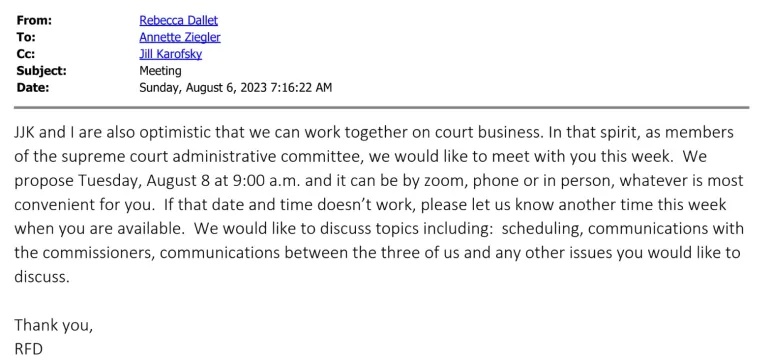
After a chaotic first week, Justice Rebecca Dallet reached out to Chief Justice Annette Ziegler about working together, in an email sent on Aug. 6, 2023.
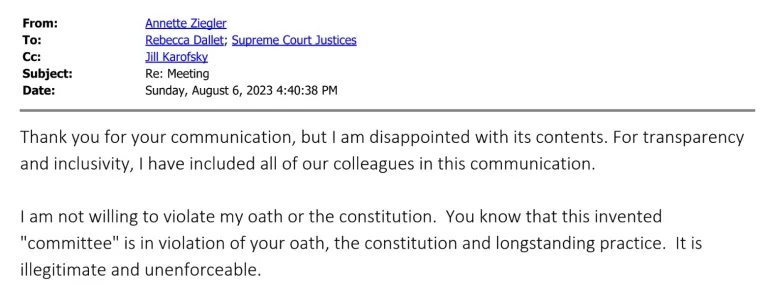
Chief Justice Annette Ziegler responds to Justice Rebecca Dallet’s email on Aug. 6, 2023, with a refusal to participate in a “sham experiment.”
During their first week in control, the liberals fired a top court official and hired his interim replacement; changed the court’s rules to shift power away from the chief justice to a three-judge, liberal majority committee; and altered the court’s operating procedures to give the majority power over key court functions, such as scheduling oral arguments.
The emails also suggest that the court’s liberal justices advanced significant personnel and rule changes after limited discussion with the full court and over strong objections from their conservative colleagues. Though the rules were adopted by a majority vote on Aug. 4, Justice Brian Hagedorn informed his colleagues he intended to write a dissent based on concerns that proper procedures were not followed, specifically a public hearing on the changes. Ziegler encouraged that the issue be discussed publicly at a previously scheduled Sept. 7 hearing.
Additional correspondence obtained by Wisconsin Watch from the secretary of state’s office further highlights the chaotic nature of the first week of liberal rule. State officials struggled to locate Justice Janet Protasiewicz’s oath of office — which she signed more than a week before taking office — even as she had started to weigh in on court matters.
The state Supreme Court emails and documents reviewed for this story were released separately to Wisconsin Watch by the court’s conservative members: Ziegler, Hagedorn and Justice Rebecca Bradley. The court’s liberal members, Dallet, Karofsky, Protasiewicz and Justice Ann Walsh Bradley, did not release responsive records before publication. Matthew Woleske, an aide to Dallet, said in an email that the justice “is actively working on a response” to Wisconsin Watch’s records request and the news organization “will receive a response as soon as practicable and without delay.”
Personnel changes sparked first public feud
On Monday, July 31, then-Director of State Courts Randy Koschnick received a phone call from Karofsky informing him he would be fired once Protasiewicz was sworn in and liberals took control of the court. His ouster was made official two days later in a letter from Walsh Bradley.
The emails released to Wisconsin Watch show the liberal justices planned to fire him as early as June.
In an Aug. 1 email, Walsh Bradley wrote that at a June 23 conference Karofsky “announced an intention of ending the services of our current Director of State Court and implementing a new direction in court administration.”
The same email contained a draft letter on Supreme Court letterhead signed by Walsh Bradley to Koschnick informing him of his termination, as well as a draft letter to his interim replacement, Milwaukee County Circuit Court Judge Audrey Skwierawski, offering her the job. Koschnick has since filed complaints with the Wisconsin Judicial Commission against the four liberal justices and Skwierawski, alleging Skwierawski can’t serve in the role until her term expires in 2025.
Walsh Bradley called for a vote by email with responses due by noon the next day.
“Political purges of court employees are beyond the pale,” Rebecca Bradley tweeted less than an hour after Walsh Bradley sent her email. “Four or five justices secretly voting on court matters without the court actually meeting breaches universal judicial norms. This abuse of power is unprecedented and illegitimate. It should be condemned by all judges.”
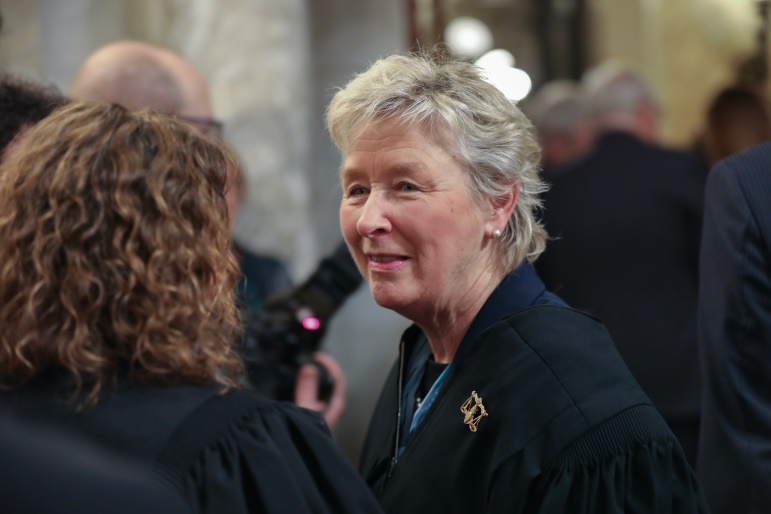
Liberal Justice Ann Walsh Bradley has tried to communicate directly with conservative Chief Justice Annette Ziegler, but Ziegler has rebuffed attempts to work together. She is seen at the state Capitol building in Madison, Wis., on Jan. 22, 2019. (Emily Hamer / Wisconsin Watch)
Ziegler wrote soon after in response to Walsh Bradley’s email that “any action taken on this is illegitimate.”
But the liberal justices forged ahead. Dallet seconded Walsh Bradley’s motions to fire Koschnick and hire Skwierawski, and all four liberal justices, throughout the course of the day on Aug. 1, voted in favor of both efforts.
The liberal justices have not publicly stated an explanation for why they fired Koschnick.
“I vote against the motions, both as a matter of substance and process,” Hagedorn wrote on Aug. 1. “The Director of State Courts is probably our most important hire. I understand that the intention to take this action was communicated at the end of the last term. But I believe process and transparency matter.”
Dallet wrote back defending the liberal justices’ actions, saying that in a May 19 email, Walsh Bradley had notified the court that “she would be reviewing our procedures in an effort to make the court more open and inclusive.”
That invoked a fiery response from Rebecca Bradley, who referenced the liberal justices’ concerns about the process used to hire Sam Christensen as clerk of the Supreme Court and Court of Appeals. Christensen started in the role June 18.
In a May 18 email to Koschnick and the other justices, Karofsky expressed concerns about, among other things, moving forward with interviews for the clerk position because at that point, no justices had been involved in screening candidates, adding that “we need to hit the pause button on this process so that we can discuss the best way to proceed at this juncture.”
“The process being currently employed is inconsistent with the process we used last year when we hired (Wisconsin Supreme Court Commissioner) Tim Barber and I do not understand why that is,” Karofsky wrote. “The current process has not included a single justice or any employee from the Court of Appeals even though the Clerk works for both the Supreme Court and the COA. This seems unwise to me.”
Her concerns were echoed by Walsh Bradley, who on May 18 also called for a pause in the hiring process.
Early on May 19, Ziegler wrote back, writing that the process for hiring court personnel was consistent with previous hires.
Dallet also expressed concerns about being left out of the hiring process at that point. She wrote, “Process is important not just to making sure we hire the best person for the job but also so that we can all feel like the Clerk works for the Supreme Court and the Court of Appeals as a whole, not just a select few.”
Ziegler insisted that afternoon that the interviews would continue.
“Despite protestations to the contrary, I find the process flawed, the communications poor, and the necessary oversight by human resources lacking,” Walsh Bradley wrote in response, asking that the court schedule a conference date for the first week of August.
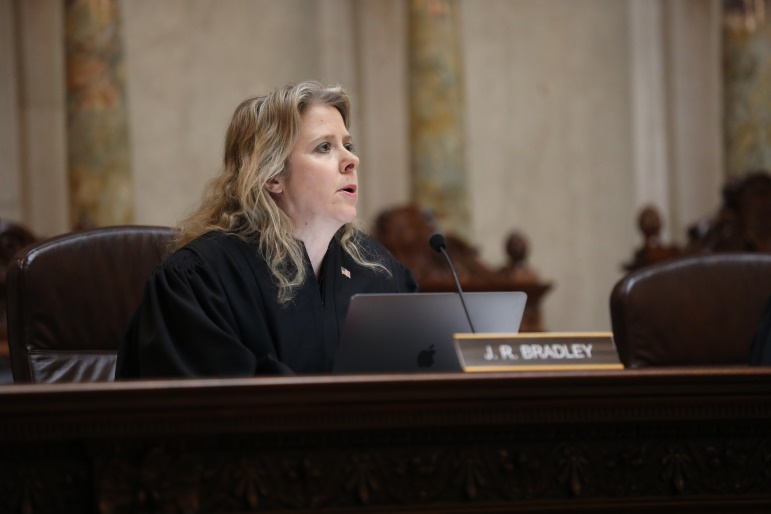
Conservative Justice Rebecca Bradley has blasted the court’s liberals for complaining that hiring procedures weren’t transparent and then moving swiftly to fire the court’s top administrator. She is seen in the Wisconsin Supreme Court Hearing Room in Madison, Wis., on Dec. 1, 2022. (Coburn Dukehart / Wisconsin Watch)
Rebecca Bradley intervened, asking: “What would be the topic for discussion?”
“I do not have a comprehensive list in mind at the moment,” Walsh Bradley wrote back. “But my overall concern is that our procedures be open and inclusive. I intend in the next month or so to review our procedures and to have a timely agenda for discussion.”
In her fiery Aug. 1 response, Bradley turned the liberal justices’ arguments about hiring court personnel back onto them:
- “Ann: have you abandoned your ‘overall concern’ ‘that our procedures be open and Inclusive’?”
- “Becky: Why have you abandoned your professed principle that ‘Process is important not just to making sure we hire the best person for the job but also so that we can all feel like the Clerk works for the Supreme Court and the Court of Appeals as a whole, not just a select few’? Is it your intention that Audrey will work for ‘just a select few’–namely you, Ann, Jill and Janet?”
- “Jill: Why are you no longer ‘concerned that we did not hammer out a process ahead of time’ for the firing/hiring of a state court director?”
Rebecca Bradley asked the justices to remove her name from the letterhead informing Koschnick of his removal. The liberal justices proceeded with the personnel changes on a letter bearing Walsh Bradley’s letterhead, rather than all seven justices of the Supreme Court.
Oath goes missing: ‘This is odd!’
On the morning of Aug. 1, as liberal justices began circulating proposals related to replacing court personnel, Ziegler asked the group: “As this email was sent about 9 AM this morning and Janet was included on it, what time was she sworn in?”
Karofsky responded a few minutes later saying she had been sworn in prior to midnight and her papers had been filed with the secretary of state’s office. Protasiewicz confirmed the details 10 minutes later, writing: “That is accurate. I took my oath a week ago. Papers have been filed.”
The newest justice’s comments were met with suspicion by Rebecca Bradley.

Text messages sent on Aug. 1, 2023, between Secretary of State office staff highlight some of the confusion and chaos the first week of the Supreme Court’s new term.
“So there were eight justices for a week?” Bradley asked that afternoon, noting that “Article VII, Section 4 of the Wisconsin Constitution Provides: (1) The supreme court shall have 7 members who shall be known as justices of the supreme court. Justices shall be elected for 10-year terms of office commencing with the August 1 next succeeding the election.”
A copy of Protasiewicz’s oath of office obtained by Wisconsin Watch shows that she took her oath on July 23 and filed it on Aug. 1. Other justices have also taken their oaths before the first day of their term, records obtained by Wisconsin Watch show. Justice Ann Walsh Bradley, for example, took her most recent oath of office on July 10, 2015, and filed it with the secretary of state in September 2015.
“Hey Nate, (just so you know), we just got two questions from reporters asking if we have Protasiewicz’s oath of office,” she wrote to Nathan Schwantes, the secretary of state’s chief of staff, at 2:49 p.m. “We’re having some difficulty finding it.”
Menchhoff and another staffer then walked over to the state courts’ office to see if they had the oath, but returned empty-handed.
In a later message, at 3:34 p.m., Menchhoff told Schwantes that “they’re saying they walked it over.”
At 3:36 p.m., John Newman, a part-time staffer in the secretary of state’s office, reported that the oath had still not been delivered.
“This is odd!” Menchhoff wrote back.
“Maybe they got intercepted by a protester or something?” Newman replied.
“Lost in the tunnels?” Schwantes offered.
At 3:38 p.m. Newman shared that the oath had been collected by staffers in the secretary of state’s office.
Accusations fly over rule changes
During the debate about Koschnick’s future, Dallet also commenced a discussion about changes to how the state Supreme Court operates.
On Aug. 1, Dallet wrote to her colleagues, reminding them of Walsh Bradley’s request for an August meeting, suggesting they meet in person Aug. 4 and sharing draft policy changes.

An Aug. 1, 2023, email shows Chief Justice Annette Ziegler trying to halt the scheduling of an administrative hearing the first week of the new court term.
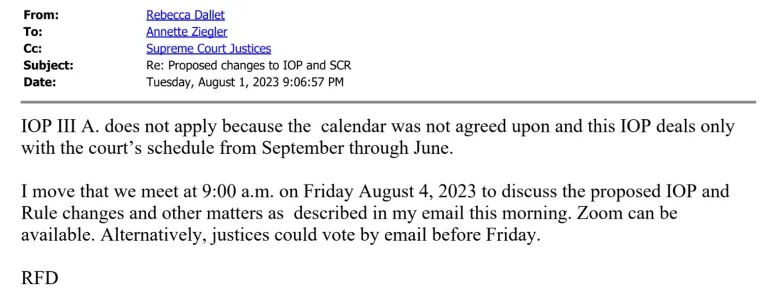
Justice Rebecca Dallet disputes Chief Justice Annette Ziegler’s reason for halting the conference and moves forward with a vote. The email was sent Aug. 1, 2023.
A few hours later, Ziegler responded: “There will be no court meeting this Friday. Adding a date to the calendar requires unanimous approval of all justices. … Unless there is unanimous approval, no such court conference will be scheduled.”
Dallet called for a vote on whether to meet, which was supported by Walsh Bradley, Karofsky and Protasiewicz.
Bradley interjected that she was not available to meet Aug. 4. She also questioned whether Protasiewicz worked on the changes and when.
“During my tenure on this court, there has never been a single instance of the court failing to respect the unavailability of a justice,” she wrote. “Are the four of you going to abandon that principle too and continue meeting without all of your colleagues participating? Is this now a court of four and not seven?”
Ziegler concurred the next day, on Aug. 2: “I agree that this proposed sea change be held in open conference.”
Dallet responded on Aug. 2 that because of some of the proposed changes to the operating procedures (IOPs), some court rules (SCRs) could be implicated, creating “exigent circumstances” to change the rules.
On Aug. 4, Dallet informed her colleagues that Walsh Bradley called Ziegler the previous day to attempt to establish a date for a meeting where the proposed operating procedures and rule changes could be considered, but reported that Ziegler “again flatly refused to schedule a court conference for any date in August because it would interrupt the court’s summer break.”
“There appears to be no interest in reaching compromise,” Dallet wrote. “Thus, a majority of the court met on August 4, 2023, after having given notice of the meeting and opportunity for justices to appear in person, by zoom or to vote by email.”
Dallet concluded by writing that the liberal justices had approved several proposed changes to the operating procedures and court rules.
Under changes to the court’s rules adopted by the liberal justices during their first week in the majority, Dallet, Karofsky and Ziegler would serve on a “supreme court administrative committee” that would oversee some tasks once left to the chief justice. Liberal justices also altered the court’s internal operating procedures to give the committee scheduling power for important court proceedings, including oral arguments in cases it agrees to hear.
“What you have done is contrary to the constitution, our IOP’s and SCR’s,” Ziegler responded about 30 minutes later on Aug. 4. “Please provide me a tracked copy of your final document. The changes you have made are not legitimate or enforceable.”
Woleske replied that, per Dallet, the changes would not be released that day, prompting Ziegler’s sharp response. Woleske then shared the changes with Ziegler, who quickly made them public.
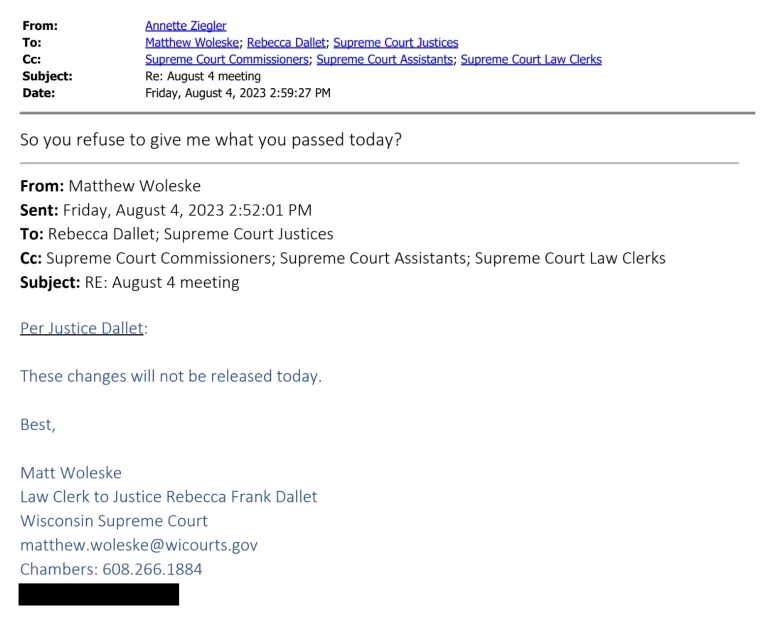
Chief Justice Annette Ziegler responds to the suggestion that the changes in court rules would not be released the day the liberal majority voted to adopt them, in this email sent Aug. 4, 2023.
An hour and 15 minutes after Ziegler released the changes, Dallet sent out an email to court administrators and staff letting them know about the changes.
Dallet later sent out her own public statement: “On behalf of a majority of justices on the Wisconsin Supreme Court, I want to express my disappointment that the Chief Justice, rather than collegially participate in a scheduled meeting of the court today, is litigating issues normally discussed by Justices either in conference or through email, through media releases,” she wrote. “It is not my intention, nor the intention of a majority of my colleagues, to continue to litigate internal issues, through the media.”
Court commissioners seek clarity on ‘intense dispute’
On Monday of the second week, the court commissioners who perform the Supreme Court’s administrative functions sought to clarify what had happened.
“As I told the court during another period of intense disputes among justices, the commissioners cannot be put in the crossfire of the court’s disagreements,” commissioner Nancy Kopp wrote on behalf of the commissioners. “As this office has done in the past, we will follow the directions of a majority of the court, subject to the court’s consistent practice of not releasing orders until all justices have voted on a matter and have been given an opportunity to attach a writing if they so choose.”
The liberal justices agreed that the orders should be released on Aug. 15 and asked that any writings justices planned to attach to the orders be circulated by then.
Hagedorn continued to raise concerns about transparency. He also questioned whether the process used to adopt the new operating procedures and rule changes violated the rules it created.
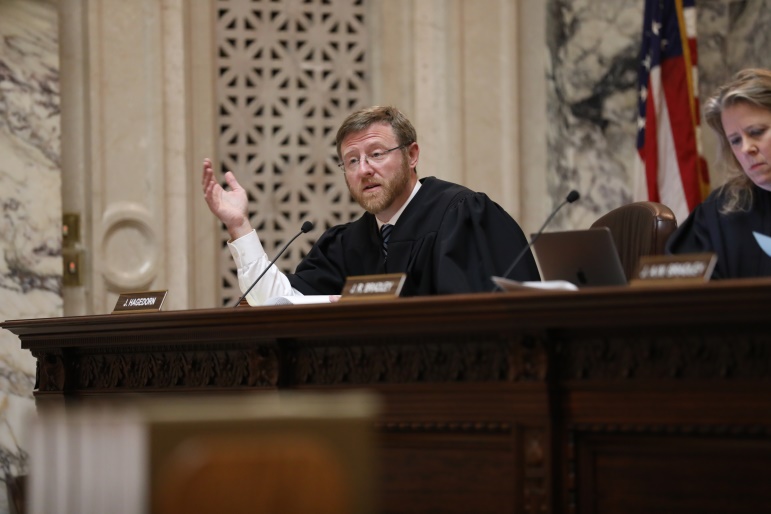
Justice Brian Hagedorn, a conservative swing vote on the court, has sided with the minority in challenging changes to court administration. He is seen in the Wisconsin Supreme Court Hearing Room in Madison, Wis., on Dec. 1, 2022. (Coburn Dukehart / Wisconsin Watch)
“If I’m understanding this correctly, this new exception (operating procedure change) creates a new mechanism by which major substantive rule changes can be made without a public hearing,” Hagedorn wrote. “The court can amend the IOPs however it wants, then skip the public hearing mandated by the IOPs, and then amend the SCRs to ‘conform’ the two. That would seem to be a get-out-of-public-scrutiny-free card that could be deployed at will.”
He concluded, “Consistent with the expressed desire to foster openness and transparency, would the majority be willing to reconsider and conduct a public hearing on these major rule changes?”
Ziegler also notified her fellow justices that she planned to write in response to the orders. A day later, on Aug. 10, she urged her colleagues to put their efforts on hold until a Sept. 7 open hearing of the court.
“We need to hear each other out,” Ziegler wrote. “I am asking that we all PLEASE PAUSE. What is happening is not good for any of us or the institution.”
She concluded, “We can and should meet and discuss these things. There is no rush to get the IOPs or SCR’s out. My hope is that while you may wish to change certain practices of the court and you have the power to do that, you do not gut the Constitutional responsibility of the Chief Justice.”
On Monday, Aug. 28, Ziegler sent out emails to reporters detailing a dispute with Skwierawski about appointing reserve judges and some of Ziegler’s objections to the rules change process. Dallet replied to Ziegler Monday night with an email she also sent to reporters in which she called Ziegler’s tone “inappropriate” and “partisan.”
She said the administrative rule changes are in effect and were enacted constitutionally by a court majority. She defended Skwierawski’s appointment. And she rebuffed Ziegler’s claim that the chief justice is the “constitutional administrator of the court,” noting the constitution “clearly” states the chief justice “shall exercise this administrative authority pursuant to procedures adopted by the supreme court.”
She also chided Ziegler for challenging the new court majority’s transparency when the conservative court had closed administrative meetings in 2012 and removed Chief Justice Shirley Abrahamson from her position mid-term following passage of a constitutional amendment that allowed them to do so.
“I am incredibly disappointed that you have chosen to play games in the media rather than communicate with members of the court privately through our procedures, or with the Director of State Courts throughout the month (despite numerous requests to do so),” Dallet wrote. “Your frantic emails and public statements notwithstanding, your power has been limited, in accordance with the constitution, which allows a majority to rule and to develop procedures you must respect.”
The nonprofit Wisconsin Watch (www.WisconsinWatch.org) collaborates with WPR, PBS Wisconsin, other news media and the University of Wisconsin-Madison School of Journalism and Mass Communication. All works created, published, posted or disseminated by Wisconsin Watch do not necessarily reflect the views or opinions of UW-Madison or any of its affiliates.
If you think stories like this are important, become a member of Urban Milwaukee and help support real, independent journalism. Plus you get some cool added benefits.



















Why are you reprinting this trashy slant on the new SSC? Where’s Gableman and his ongoing scam?
This piece by Wisconsin Watch isn’t written with a “trashy slant”. Wisconsin Watch has performed a public service by publishing a step by step account of the behavior of some members of the court.